Where’s Stripey?
Its early in the year and no doubt your focus is on number sense, trusting the count and place value. That’s my focus too, so I decided to pull one of my favourite picture books off my shelf.
By the way here is the bookshelf with picture books on it.
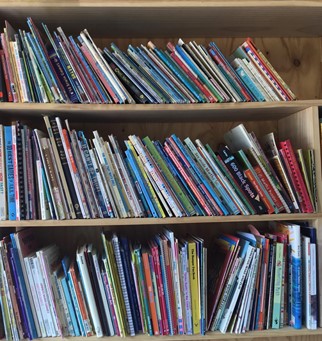
The book I chose, Where’s Stripey (Wendy Binks, Stunned Emu Press, 2006), may not at first appear to be very mathematical, after all it is not designed to be a counting book as such. However, there are opportunities for counting in 1s, 2s and 3s as well as for subitizing, counting on and importantly counting the invisible, more about this in a moment.
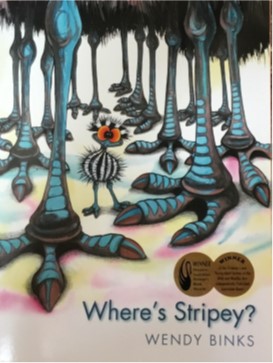
When I opened the book it still had yellow post-its on the pages where I had noted the mathematical thinking that I could draw out of each page last time I used it. This is something I do before I take a book into the classroom. It helps me to be targeted and strategic as well as to plan problems or strategy lessons as a springboard from the book.
I also list incidental, positional words within a text on post-its inside the front cover.
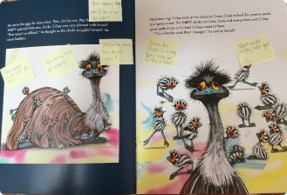
I read recently that teachers often miss the mathematical opportunities within a picture book and so miss many incidental maths opportunities. There is a body of work now that shows that the more positional words in a child’s vocabulary, the more successful they are likely to be with maths long term. Apparently, some students have as few as 6 positional words while a few have more than 400. I am compiling a list from picture books but unless we dig into the pictures as well as the words we may not get to 400. Positional ideas in the drawings also allow us to add:
under, amongst, beside, next to, side by side, into, first, last
as well as time words:
before, next morning, thirty days
and so on. What a fabulous’ rich’ text. How could you live without it?
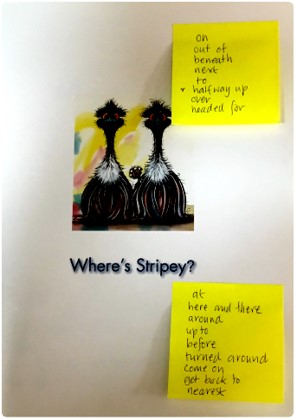
Back to the number stuff
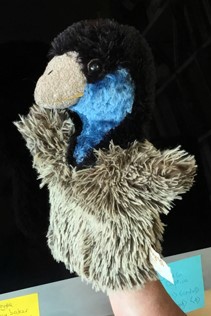
Did I tell you I even have a matching emu puppet? I mention this because Crikey, the emu puppet, knew he couldn’t count to 30 very well. When I’m using Crikey to count to 30, I like to miss a few, double dip or lose count. This allows students to focus on counting accurately and to locate errors. It also helps to make the counting purposeful.
Some questions that I had written on post-its throughout Where’s Stripey include:
What might 30 eggs look like (trusting the count, place value)
How many chicks can you see? How many are hiding? (counting the invisible)
Draw a picture or diagram to show how the thirty chicks could be organised for easy counting (unitise, subitize, use a system of 10s and 1s)
What different number sentences can we make for the tadpoles on this page?
Are there thirty in this line? How could we check? (count in 1s, 2s, cover with a plastic sleeve and loop in 2s, 5s or 10s).
How many emu eyes are looking at Crikey and Sheila? (count in 2s).
There are an awful lot of toes? How could we work out how many altogether? (count in 3s).
I can see 24 toes. How many emu chicks is that?
For more about this, check out our new place value products, Early Place Value and Place Value Mat.
About counting the invisible
In the early stages of counting students are engaged in perceptual counting. They only count what they can see and touch. It is an important step forward when students know that they can break the counting sequence and count on, so for 2 dice as shown below they will say 4,5, 6.
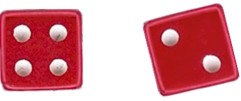
It is another step on though so to be able to count what can’t be seen. So when presented with tasks where part of the information is hidden, students need to invent ways of counting what cannot be seen, usually by finger tapping (finger gnosis). So, if presented with:
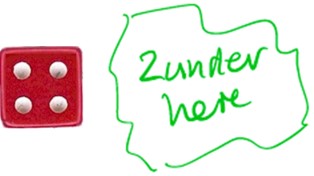
they will say 4, and tap twice as they say 5, 6.
There are many pages in Where’s Stripey that promote tapping to count the invisible.
I hope you can get your hands on a copy of this fantastic book. It works on so many levels, especially just as a good read. Let us know if you use this book and send some artwork to Johnny. We will add some of it to future blogs.
Any way we like to know how you are reacting to our blogs and what you want more/less of from us.
Cheers,

